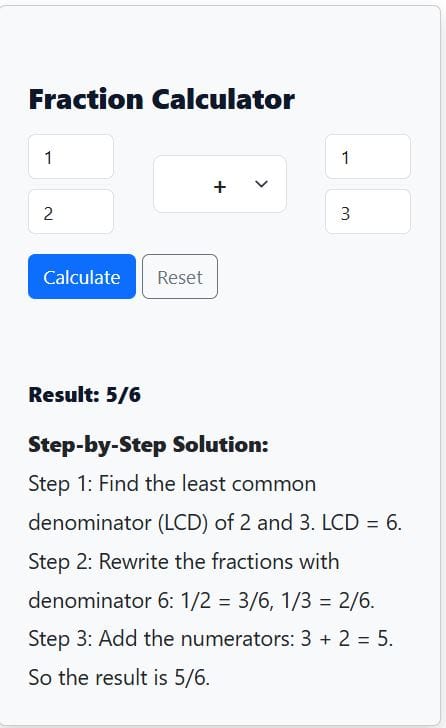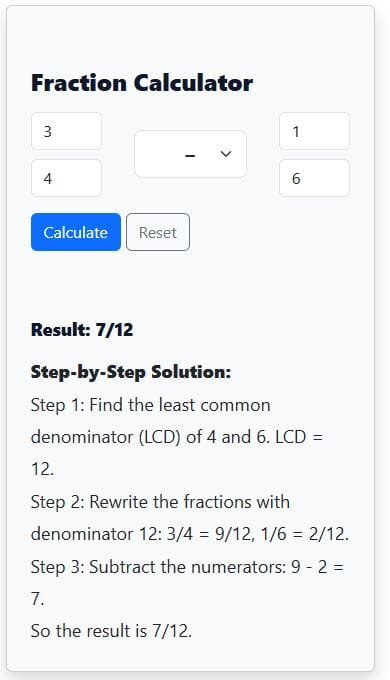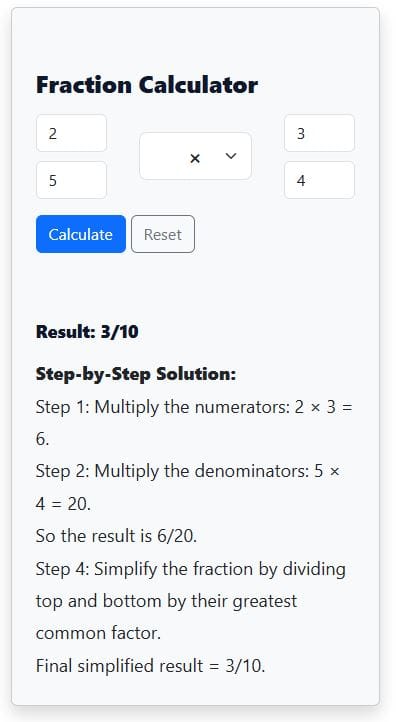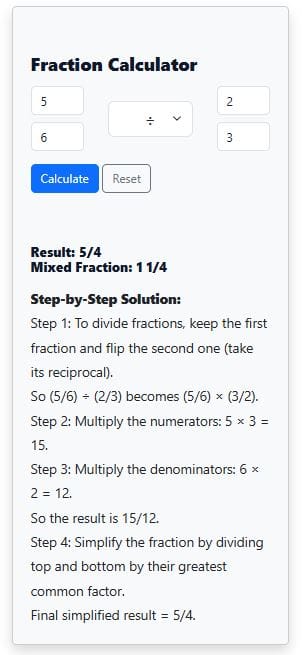This Fraction Calculator makes it easy to add, subtract, multiply, and divide fractions in seconds. Just enter your fractions, and the calculator instantly provides the correct answer with a clear step-by-step solution. Perfect for students, teachers, and anyone who wants to solve fraction problems quickly and accurately.
Easily add, subtract, multiply and divide fractions with this Calculator
Fraction Operations with Step-by-Step Examples
Working with fractions can sometimes feel confusing, especially when denominators are different. However, with a Fractions Calculator, this process becomes simple and less time-consuming. Below, we explain how to add, subtract, multiply, and divide fractions manually. After each manual example, you can also see the calculator’s solution for quick comparison.
1. Adding Fractions
To add fractions, the denominators must be the same. If they are different, find the least common denominator (LCD), then adjust the fractions before adding.
Example 1: Add 1/2 + 1/3
- Denominators are 2 and 3. The least common denominator is 6.
- Convert both fractions:
- 1/2 = 3/6
- 1/3 = 2/6
- Add the numerators: 3 + 2 = 5
- Place the sum over the denominator: 5/6
- Final simplified answer: 5/6
Similarly, using the calculator, the results are:

2. Subtracting Fractions
To subtract fractions, make the denominators the same, then subtract the numerators.
Example 2: Subtract 3/4 – 1/6
- Denominators are 4 and 6. The least common denominator is 12.
- Convert both fractions:
- 3/4 = 9/12
- 1/6 = 2/12
- Subtract the numerators: 9 – 2 = 7
- Place the result over the denominator: 7/12
- Final simplified answer: 7/12
The calculator also yield similar results as follows:

3. Multiplying Fractions
Multiply the numerators together and the denominators together, then simplify if needed.
Example 3: Multiply 2/5 × 3/4
- Multiply the numerators: 2 × 3 = 6
- Multiply the denominators: 5 × 4 = 20
- Result: 6/20
- Simplify the fraction: 6/20 = 3/10
- Final simplified answer: 3/10
The calculator also produce similar results with steps as shown below:

4 Dividing Fractions
To divide fractions, multiply the first fraction by the reciprocal of the second.
Example 4: Divide 5/6 ÷ 2/3
- Write the reciprocal of the second fraction: 2/3 becomes 3/2.
- Multiply: (5/6) × (3/2)
- Multiply the numerators: 5 × 3 = 15
- Multiply the denominators: 6 × 2 = 12
- Result: 15/12
- Simplify the fraction: 15/12 = 5/4
- Final simplified answer: 5/4 (or 1 1/4 as a mixed number)
The fractions calculator also yield similar results with step-by-step explanation as follows:

Frequently Asked Questions
A fraction calculator is an online tool that helps you quickly add, subtract, multiply, and divide fractions. Our calculator also gives a step-by-step solution, making it useful for learning and practice.
To add fractions with different denominators, enter both fractions in the calculator and choose addition. The adding fractions calculator with steps will automatically find the common denominator and show you the full working process.
Yes. You can use it as a subtract fractions calculator. Just enter the fractions, choose subtraction, and click calculate. The tool will give you the final simplified answer and the step-by-step working.
When you use it as a multiply fractions calculator, it multiplies the numerators together and the denominators together. The tool then simplifies the result and shows each step clearly.
To divide fractions manually, multiply the first fraction by the reciprocal of the second. With our divide fractions calculator, you only need to enter the numbers. The calculator shows the final answer and explains the steps in detail.
Yes. After solving, the calculator gives the answer in its simplest form and also shows the working that led to the simplified result.